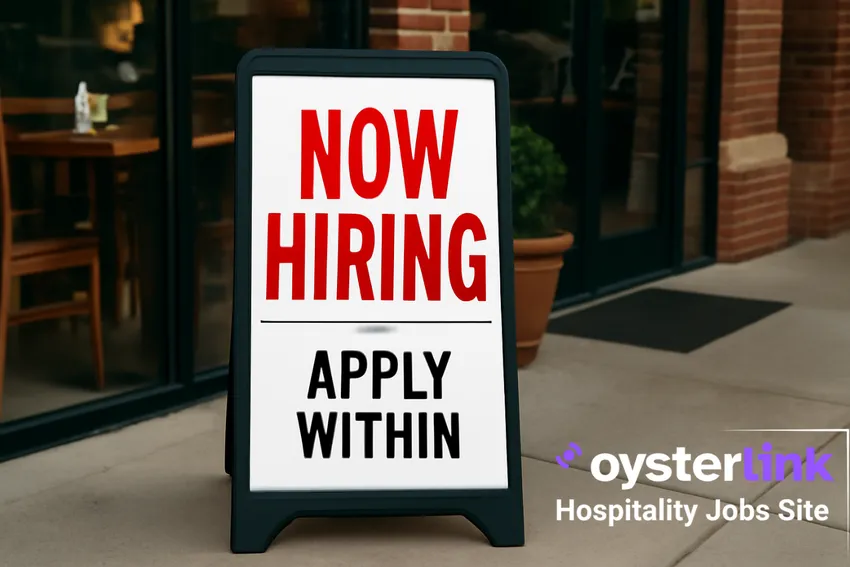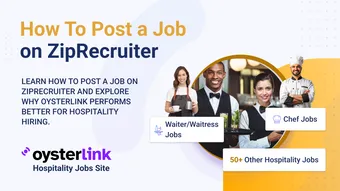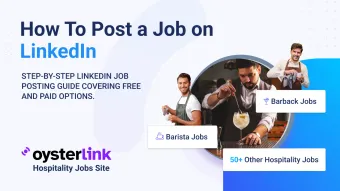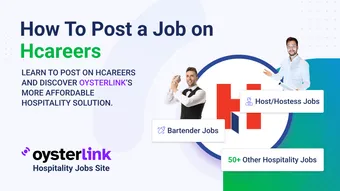Key Takeaways:
- Traditional hiring methods like agencies and job fairs can be costly and time-consuming.
- Employee referrals offer faster, cheaper hires with better retention.
- Online job boards dominate seasonal hiring in 2025, led by cost-effective options.
- OysterLink is the fastest-growing hospitality job board, charging only $150 per post.
- A small hiring investment now ensures qualified staff and higher seasonal profits.
Hiring restaurant and hospitality staff is critical – and expensive. But the costs of finding and onboarding that help can add up fast.
Studies show that the average cost to hire a new worker (across all industries) is around $4,100; for a low-level restaurant hire it’s about $1,700.
Because time is short, many restaurants rely on traditional hiring methods. These include staffing agencies, employee referral bonuses, job fairs and even walk-in applications.
However, in 2025, online job posting is king for hiring.
Let's summarize each below and break down the estimated costs, timeframes, pros and cons of each method.
OysterLink (New Hospitality Job Site)
OysterLink is a new niche job board built just for restaurants and hotels. Unlike generic sites, it’s designed for hospitality hiring. OysterLink “filters out the fluff, leaving you with a pool of professionals who check all the right boxes”. It only lets hotels, restaurants, caterers, etc. post and apply.
The platform provides rapid results – a majority of job postings receive qualified applications within 24 hours. In other words, you could post for a Server or a Cook and see resumes by next day.

Pricing
OysterLink job ads start from $150 per job post. That’s a fraction of typical fees on other sites (compare to $299+ on ZipRecruiter or $150+/month on LinkedIn). For restaurant owners on tight budgets, $150 is very attractive, especially considering your job post will be featured on the homepage to capture the attention of over 400,000 monthly visitors.
If you also want to be featured on social media and in the newsletter, as well as get interviews and brand promotion for you business, feel free to post an inquiry here.
Usability
The site is optimized for hospitality recruiters and managers. It offers pre-written job-description templates for restaurant and hospitality positions (so you spend minutes, not hours, crafting an ad) and insights like wage trends. The interface is mobile-friendly and focused: there are no unrelated tech or finance jobs.
You simply select a role (e.g. Server, Host, Line Cook, Dishwasher, Assistant Manager) and post. OysterLink has an easy, modern UI — a boon for time-pressed owners. So for example, front-of-house roles like Servers or Hosts typically get dozens of applicants online and OysterLink’s specialized pool may yield more qualified people.
Reach & Effectiveness
Though new, OysterLink’s growth has been rapid in 2024-25. It already provides access to hundreds of thousands of hospitality job-seekers.
Because it’s targeted, candidates on OysterLink expect restaurant and hotel work. For example, a Server applicant on OysterLink knows the industry – versus a generic applicant on Craigslist who might not. In practice, this means better-fit resumes.
Other Online Job Posting Platforms
Other platforms can fill the gap, but each has trade-offs. See the specifics below:
- Craigslist: Craigslist postings cost roughly $25 (low population areas) up to $75 (big cities) per job category. The reach is more local. Craigslist is very popular for hourly and part-time roles (like Line Cooks or Servers) because it’s cheap and easy. Time-to-hire can be very fast (applicants often respond within a day), but you’ll wade through a lot of generic replies and even spam. Many restaurants still post on Craigslist out of habit, but its low cost comes with heavy screening work.
- ZipRecruiter: This all-in-one site syndicates postings to dozens of smaller boards. ZipRecruiter plans start around $299 per month for a single active job (and higher tiers up to $719+ for multiple listings). It’s pricier, but it streamlines posting and applicant tracking. ZipRecruiter’s AI also “pushes” jobs to candidates it thinks fit. Usability is strong, but its high cost can be a barrier for small restaurants.
- Indeed: Often the first stop, Indeed lets you post jobs for free (basic listing) or pay to “sponsor” for visibility. Sponsored jobs start at about $5 per day (or $150 per month), with budgets automatically spent on clicks or applications. Indeed attracts hundreds of millions of monthly users globally, so your ad can reach a huge audience. The flip side is volume: you may get dozens of unqualified applicants if you don’t set filters. Many employers eventually sponsor an Indeed posting to ensure visibility, which is why typical budgets of a few thousand dollars per role are common for high-demand positions.
- Niche Boards & Social Media: There are industry-specific sites (Poached, HCareers, Snagajob, etc.) and local labor pools. These vary in price (some have free community listings, others a small fee). Social media (Facebook, Instagram) is also used: advertising jobs on Facebook can be inexpensive (tens of dollars) with targeted reach, but those methods are beyond the scope of this article.
OysterLink undercuts these on price and hones in on hospitality. (Even LinkedIn’s “easy apply” is more for professionals and costs $150–$500 per post.)
In short, OysterLink aims to be the go-to site for busy restaurateurs. While traditional sites are generalists, OysterLink is a hospitality specialist — and in a tight labor market, that focus can be a real advantage.
Traditional Hiring Methods
Hiring staff through traditional methods still plays a major role in the restaurant and hospitality industry. While some approaches are cost-effective, others demand significant investment—especially when speed and quality are priorities.
Below are the most common methods, along with their typical costs, pros and drawbacks.
Recruitment Agencies
Temp agencies and recruiters can quickly source candidates, especially for hard-to-fill or management roles (e.g. assistant manager, chef). Agencies typically charge 15–30% of the new hire’s first-year salary.
For example, filling a $50,000/year assistant manager slot at a 20% fee means roughly $10,000 to the agency.
The upside is that the recruiter handles screening and often maintains a large candidate pool; the downside is the high fee and potential mismatch with hospitality culture. (Some specialized hospitality staffing firms may charge by the hour with a markup of 25–75%.)
Employee Referrals
Many restaurants offer referral bonuses to employees who recommend new hires. These bonuses vary widely – typically $100–$1,000 (sometimes up to $10,000 for hard-to-fill jobs) per successful hire.
The beauty of referrals is minimal upfront cost and a faster hire. Indeed, referred candidates join much quicker – often in about 29 days on average, roughly a month faster than standard hires. Referred workers also tend to fit better culturally and stay longer.
On the flip side, referrals rely on existing staff networks (so the pool is small) and can reduce diversity if everyone refers similar friends.
Job Fairs
Participating in local career or hospitality job fairs can be an effective face-to-face recruitment method. Employers typically pay a booth or registration fee that varies by event – small local fairs might be a few hundred dollars, larger expos up to $1,000 or more.

You also incur travel and preparation time. The advantage is meeting many candidates in person and conducting on-the-spot interviews.
The drawback is limited reach (candidates must attend the event) and potentially low turnout. In the table below we estimate a typical job-fair fee in the low hundreds and note that time-to-hire remains on the order of weeks.
Walk-in Applications
Posting a “Help Wanted” sign or leaving applications at your door is essentially free aside from making the sign. In practice this means no advertising spend, but you do spend staff time interviewing anyone who drops by. This method can work well for front-of-house roles (hosts, servers) in high-traffic locations. It yields local applicants quickly (sometimes the same day) but results vary – you may get few qualified candidates. There is no citation for “walk-in apps” cost since it’s so minimal, but the key is that it trades money cost for staff time.
These traditional methods vary a lot in cost and speed. For a quick summary, see the table below.
| Method | Approximate Cost | Time to Hire | Pros | Cons |
|---|---|---|---|---|
| Recruitment Agencies | 15–30% of salary (e.g. $7–15K) | Several weeks–1–2 months | Extensive screening; access to passive candidates | Very high fees; less control; generic candidates |
| Employee Referrals | Often only bonus ($100–$1K) | ~4 weeks (e.g. 29 days) | Very fast hire; better cultural fit; low out-of-pocket cost | Small pool; potential for homogeneity |
| Job Fairs | $100–$300+ per event | 1–2 weeks (plus event prep) | Meet multiple candidates at once; on-site screening | Can be costly; reach limited; requires travel/time |
| Walk-in Ads | Essentially $0 (sign printing) | 0–4 weeks (as candidates show up) | No ad spend; quick local response possible | Hit-or-miss turnout; time-consuming interviews |
| Online Job Boards | Free–$700+ | Days to weeks | Very wide reach; 24/7 posting; many applicants | High competition; may require paid boosts; screening burden |
The table above shows typical costs and timelines. For example, agencies’ percentage fees are well documented, and career fairs often run a few hundred dollars per booth. When hiring managers crunch numbers, they often find that online job boards dominate recruiting spend.
Conclusion
In 2025, hiring quality staff quickly – while controlling costs – is essential for restaurant profitability. As the table above shows, methods like agencies or job fairs can work, but at a price. Online postings now dominate sourcing.
And with dozens of job boards to choose from, one platform stands out for hospitality. OysterLink’s $150 per post is tiny compared to the value a good hire brings.
A single full-time Server can cover that cost in one week of sales, yet drive revenue for months. By investing even $150 in a targeted ad on OysterLink, owners tap into a pool of trained hospitality workers and minimize time spent on recruiting.
Ultimately, the best strategy is to use multiple channels: referrals, some local ads, and online listings. But when every hour of the season counts, a low-cost, high-impact platform matters.
OysterLink’s easy interface and high exposure mean that for just $150 you can quickly attract qualified servers, hosts, cooks or even assistant managers. That’s a small price for high-quality hires who help staff the rush, satisfy customers, and boost the bottom line during the busiest season.







Loading comments...